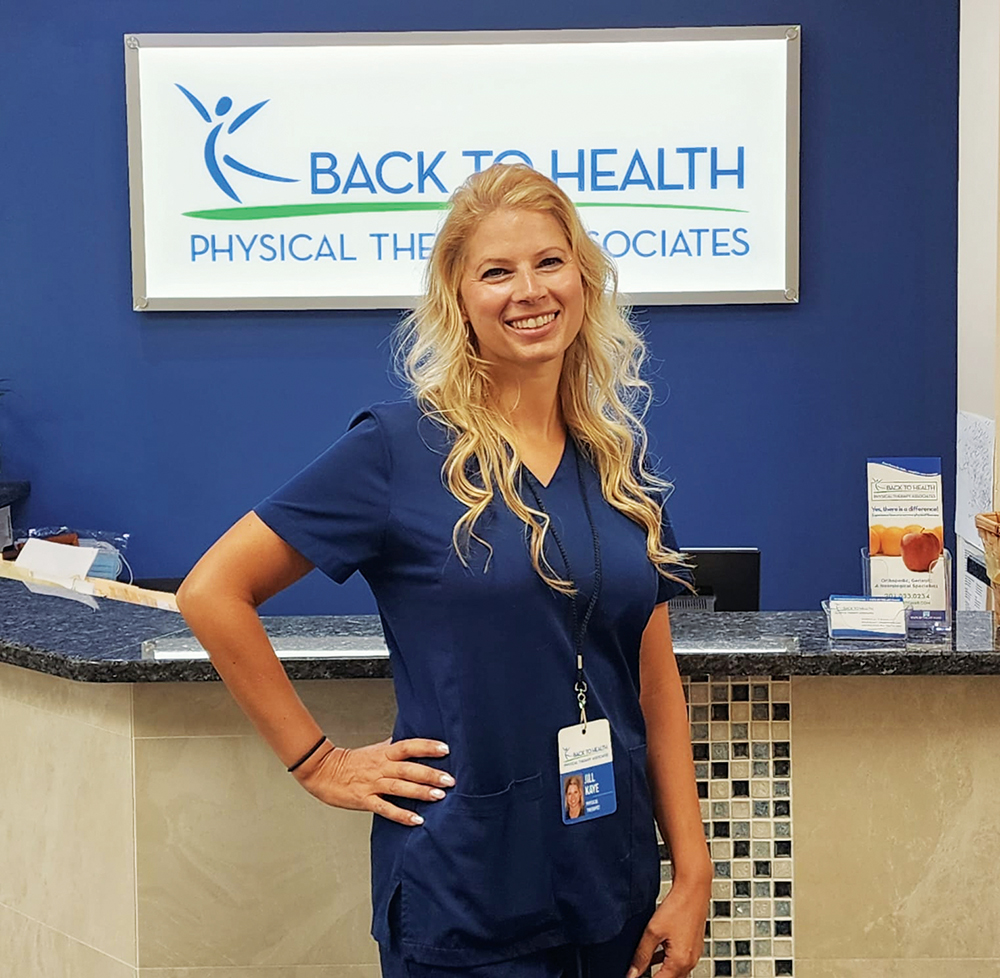
My name is Jill Kaye, and I have been a physical therapist for 23 years. I am excited to share information about Back to Health Physical Therapy’s new program which focuses on post-mastectomy and post-radiation breast cancer patients.
As a teenager, I witnessed my mother suffer from this debilitating disease. Years later, I made the difficult decision to undergo a prophylactic double mastectomy, making me a “previvor,” as I had taken the initiative to have a mastectomy to avert cancer due to my genetic predisposition to this life-shattering disease.
I know firsthand how painful, emotionally draining and frustrating the recovery process can be. It is important to me that my patients feel comfortable and heard. Unfortunately, there can be many complications, including physical and functional limitations, which can develop during the treatment of breast cancer. Studies have shown that 66% of breast cancer patients reported functional problems related to their cancer treatments. Despite this statistic, less than 10% of these patients are referred for physical and occupational therapy rehabilitation. The American Cancer Society recommends that the patient confirm with their doctor prior to starting an exercise program and that they should consult a physical therapist or occupational therapist specifically trained to design an exercise program individualized for each patient.

My personal experience has driven me to help others undergoing this process, and it has been my career-long dream to implement a specialized program for breast cancer patients. My goal is to make physical therapy a mainstay modality in a successful and comprehensive treatment process. I am fortunate to work for an employer who is just as enthusiastic about developing a specialty program to help these incredibly brave women heal both physically and emotionally.
“Jill approached me with her personal vision for this program,” said Loren Simpson, co-owner of Back to Health Physical Therapy. “She is so passionate about it—and I am confident that we can help so many women in our community recover. Back To Health’s goal is to not only help heal the body through targeted and skilled therapy techniques, but we also want to help the patients in a warm, caring environment which allows the patient to relax and not feel like they are at yet another medical appointment. We have a private ‘Tranquility Treatment Room,’ which helps the patients relax and receive the best possible care in a conducive environment for physical and emotional healing. Our private treatment room offers personalized music, a heated table, natural plants, specific positioning equipment for breast cancer patients, a height adjustable treatment table, and soothing topicals for scar massage, pain, swelling reduction and overall healing. The tranquility room is not a curtained space in an open area—it is a closed-door room—including a mat table where our patients can do their therapeutic exercises in private as well.”
It is highly beneficial for a patient to start with one physical therapy visit prior to their surgery to establish baseline measurements pre-operatively. This would be an optimal time to educate the patient on post-operative movement restrictions and the patient would receive a customized home exercise program that may begin the day after surgery. The home exercise program will help to facilitate lymphatic regeneration and reduce the risk of complications that can prolong the healing process, such as seroma formation, axillary web syndrome and lymphedema, while ensuring shoulder joint mobility.
Post-operatively, your therapist will continuously reevaluate objective measurements and begin to address any soft-tissue restrictions with soft-tissue mobilization and myofascial release techniques. Gentle stretching and strengthening exercises will be performed as tolerated to optimize flexibility and strength.
Back to Health’s highly skilled physical and occupational therapists can provide specialized, breast cancer-oriented therapy practices along with treatments with state-of-the-art equipment such as low light laser therapy (LLLT). According to studies by the NIH (National Institutes of Health), LLLT blocks nerve transmissions for pain relief while boosting cells’ detoxification and regenerative abilities. Additionally, the NIH studies conclude that LLLT is also proven to be effective in reducing the limb volume, increasing shoulder mobility and hand grip strength in approximately 93% of patients with post-mastectomy lymphedema.

Like most surgeries, post-mastectomy patients require a significant amount of time to recover—which would require the patient to stay in bed and rest, and they will not be able to drive for several weeks or longer. Not to worry, Back to Health has a team of physical and occupational therapists who can provide therapy in the comfort of your own home. The patients can recover fully at home, or they can start at home and graduate to the clinic when they are ready.
We most enthusiastically welcome the opportunity to work with pre- and post-mastectomy, chemo and radiation patients, and look forward to exemplifying how effective the role of a specially trained physical or occupational therapist can be in improving the outcomes for breast cancer patients.
For more information about Back to Health’s Breast Cancer Rehab program, please scan QR code, or call 201-833-0234.
Jill Kaye is a physical therapist who has been providing one-on-one care to her patients with Back to Health Physical Therapy for over 15 years. Outside of work, Jill loves spending time with her two teenage daughters and her two rescue dogs. She enjoys good hikes, DIY projects, and hosting gatherings for family and friends.







